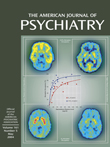To the Editor: In their article, David Veale, M.D., and colleagues
(1) reported the interesting finding that 20% of 100 patients with body dysmorphic disorder had a lifetime job (7%) or education (13%) in art or design. This was the case for only 4% of the patients with a major depressive episode, 3% of those with obsessive-compulsive disorder, and 0% of those with posttraumatic stress disorder. Dr. Veale et al. hypothesized that this finding may reflect an appreciation of esthetics in individuals with body dysmorphic disorder, which may contribute to the disorder’s development in some patients. An equally plausible explanation is that patients with body dysmorphic disorder tend to develop an interest in esthetics.
Because this intriguing issue has not otherwise been studied, to our knowledge, we determined the rate of employment as an artist for 146 consecutive participants (69% women, mean age=32.2 years, SD=11.4) in an ongoing prospective naturalistic study of the course of body dysmorphic disorder. Data on current occupation (during the past 6 months) was obtained by an investigator blind to any hypothesis about an association between occupation and a diagnosis of body dysmorphic disorder. The subjects were categorized as artists by using the definitions of Dr. Veale et al.
(1). We also estimated the proportion of individuals in the United States currently employed as artists, based on the 2000 Occupational Employment Statistics survey
(2). This survey collects nationwide occupational data (excluding self-employment) based on the government-wide Standard Occupational Classification system. Because this system does not report adequately detailed statistics for several of the artist categories used by Dr. Veale and colleagues, we made several assumptions to derive our estimate (for example, the Occupational Employment Statistics survey reports the number of postsecondary art, music, or drama teachers, which we divided by 3 to derive an estimate for art teachers). Because of insufficient detail, several teacher categories were excluded from our analyses, so our estimated rate of artists in the general population is likely an underestimate.
Of the 146 subjects with body dysmorphic disorder, 1.4% (N=2) (95% confidence interval [CI], 0%–3.3%) were currently employed as artists. The estimated rate in the general population was 0.64% (753,283 of 117,006,770) (95% CI=0%–1.4%). Thus, the proportion of subjects with body dysmorphic disorder who were employed as artists was approximately twice that in the general population.
Our rate of 1.4% cannot be directly compared to the rate of Dr. Veale et al. of 20% because their rate includes education in art/design, which we did not assess. Nor is our rate directly comparable to the employment rate of 7% of Dr. Veale et al. because we assessed only current—not lifetime—occupation. Nonetheless, our rate is notably lower than that of Dr. Veale et al.; however, it is still higher than that in the general population and thus offers modest support for the hypothesis that body dysmorphic disorder is associated with employment as an artist. Our findings are based on a small group, however, and should be considered preliminary. Further research is needed to elucidate factors that may contribute to body dysmorphic disorder’s development, as this important topic has received little investigation.

